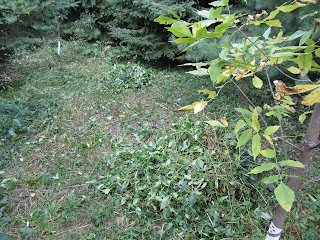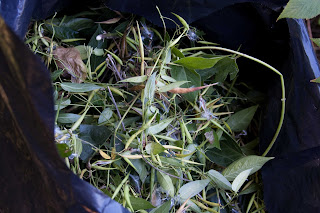Barry, Geoff, Hedrik, Marg
Today was a rather frustrating experience, as we
all dealt with the bagging of mulched and newly cut DSV in the field south of
the pond. Geoff completed the bagging in the area he had scythed on Saturday
then joined the rest of us in cleaning up. The south slope of the pond already
had some piles ready for bagging, but other loose materials from previous
cuttings needed to be raked up and bagged as well. The central part of the
larger field south of the pond trail was our main focus. Tidying this up was
pretty hard work, as the mulched DSV was reduced to long, hardy vines mixed
with new growth that was difficult to cut. But at the end of the morning, 28 bags
were waiting along the Green Heron Road for pickup by AAFC.
 |
| View of east side of the field. |
 |
| View from the bridge - the group was all over that field! The orange bush in the pond is the water willow, most of which was removed on Friday afternoon as noted below. |
Friday, September 30: Barry came in for a shift that had little to do with the usual TISG activities. He spent some time with a group working in the Butterfly Meadow. There is still some DSV there but his main task was getting a section ready for tilling. After lunch, Barry, Brian and Diane worked for an hour or so on invasives in the pond. Brian and Diane put on chest-waders and braved the mucky bottom, filling buckets with frog-bit and flowering rush that Barry emptied into a wheelbarrow for carting off to dump on unsuspecting DSV. One way to solve the mulch issue! Four barrow loads with 5 or 6 bucketsful each totted up to quite a bit of material being removed. About 30 Black and Mallard ducks didn't seem to mind our being there - they still had lots of duckweed left and we were an improvement over the crazed mutt that was braying and chasing them earlier in the day.



















